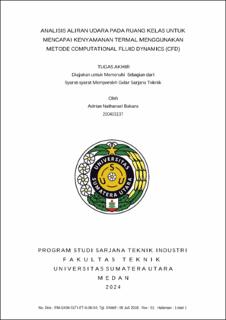| dc.contributor.advisor | Huda, Listiani Nurul | |
| dc.contributor.author | Bakara, Adrian Nathanael | |
| dc.date.accessioned | 2025-05-21T06:58:38Z | |
| dc.date.available | 2025-05-21T06:58:38Z | |
| dc.date.issued | 2024 | |
| dc.identifier.uri | https://repositori.usu.ac.id/handle/123456789/103973 | |
| dc.description.abstract | A comfortable environment plays an important role in creating ideal conditions for
classrooms. One important part of an ideal environment is having comfortable
thermal conditions. Human thermal comfort basically depends on the airflow
structure and the heat transfer mechanism that occurs between the human and the
surroundings. Good airflow distribution in air-cooled classrooms will create a
comfortable indoor thermal environment and benefit the physical and mental health
of students and improve work efficiency. Based on the results of previous research
conducted in FT USU classrooms as many as 71 of 393 students feel thermal
discomfort when learning in classrooms that use air conditioning. This study aims
to analyze the effect of variations in the type of cooling facilities used in an effort
to achieve thermal comfort by analyzing the distribution of air flow using
Computational Fluid Dynamics (CFD) simulation in the classroom of the Faculty
of Engineering, University of Sumatra (FT USU) Medan. This study also analyzed
the level of thermal comfort using the Predicted Mean Vote (PMV) and Predicted
Percentage Dissatisfied (PPD) methods. The results showed that there is a nonuniformity
of airflow in each classroom of the object of research caused by the nonuniformity
of the type of cooling facilities. Rooms that use fans produce 75% higher
airflow than rooms that use air conditioners. Based on the results of the air
distribution simulation using CFD, 3 rooms using air conditioning from 5
classrooms of the research object have met the thermal comfort standards
according to SNI 03-6572-2001 regarding the average wind speed in the classroom.
The simulation results show that the room that uses a fan produces 15% higher air
temperature than the room that uses air conditioning. Thermal comfort assessment
results show that classrooms using fans produce PMV value of 81.9% and PPD
value of 87.8% higher than classrooms that use air conditioning. | en_US |
| dc.language.iso | id | en_US |
| dc.publisher | Universitas Sumatera Utara | en_US |
| dc.subject | Computational Fluid Dynamics (CFD) | en_US |
| dc.subject | Airflow | en_US |
| dc.subject | Thermal | en_US |
| dc.title | Analisis Aliran Udara pada Ruang Kelas untuk Mencapai Kenyamanan Termal Menggunakan Metode Computational Fluid Dynamics (CFD) | en_US |
| dc.title.alternative | Airflow Analysis in Classrooms to Achieve Thermal Comfort Using Computational Fluid Dynamics (CFD) Method | en_US |
| dc.type | Thesis | en_US |
| dc.identifier.nim | NIM200403137 | |
| dc.identifier.nidn | NIDN0002046903 | |
| dc.identifier.kodeprodi | KODEPRODI26201#Teknik Industri | |
| dc.description.pages | 122 Pages | en_US |
| dc.description.type | Skripsi Sarjana | en_US |
| dc.subject.sdgs | SDGs 9. Industry Innovation And Infrastructure | en_US |


